
Abandoned & Little-Known Airfields:
Southwestern Arkansas
© 2002, © 2016 by Paul Freeman. Revised 10/15/16.
This site covers airfields in all 50 states: Click here for the site's main menu.
____________________________________________________
Please consider a financial contribution to support the continued growth & operation of this site.
Chaffee Army Airfield (revised 10/15/16) - Eberts Field (revised 4/26/14) - (Original) Saline County Airport (revised 7/1/15)
____________________________________________________
(Original) Saline County Airport, Benton, AR
34.56, -92.61 (Southwest of Little Rock, AR)

The original Saline County Airport, as depicted in the 1968 Flight Guide (courtesy of Bob Levittan).
According to Wikipedia, the original Saline County Airport “opened in 1957.”
The earliest depiction of Saline County Airport which has been located was in the 1968 Flight Guide (courtesy of Bob Levittan).
It depicted Saline County Airport as having a single paved 3,370' Runway 18/36, with a ramp & 2 buildings on the west side.

The earliest photo which has been located of Saline County Airport was a 3/9/70 USGS aerial photo.
It depicted the field as having a single asphalt Runway 18/36, with several hangars on the northwest side,
and a variety of aircraft parked on the northwest & northeast, including a Douglas DC-3.

The 1977 USGS topo map depicted the Saline County Airport as having a single north/south runway.
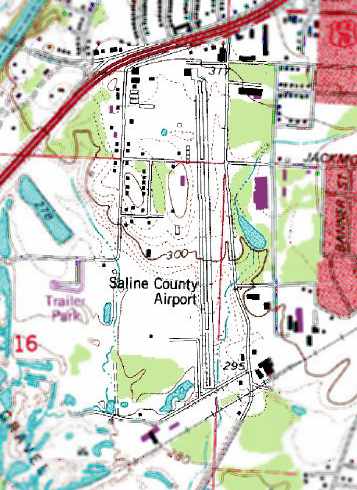
The 1988 USGS topo map (courtesy of Devan Mayer) depicted Saline County Airport as having a single paved north/south runway.
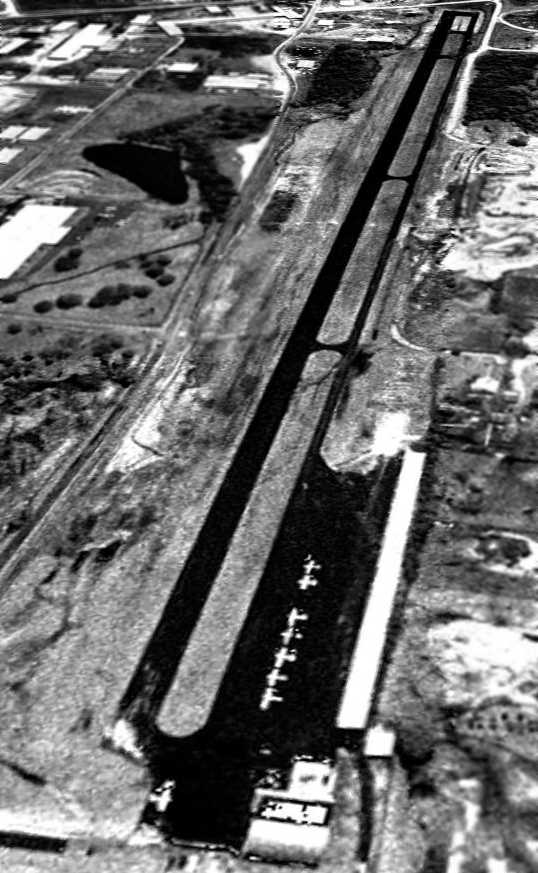
A 2/23/94 USGS aerial view looking southeast depicted 8 single-engine aircraft parked at Saline County Airport.
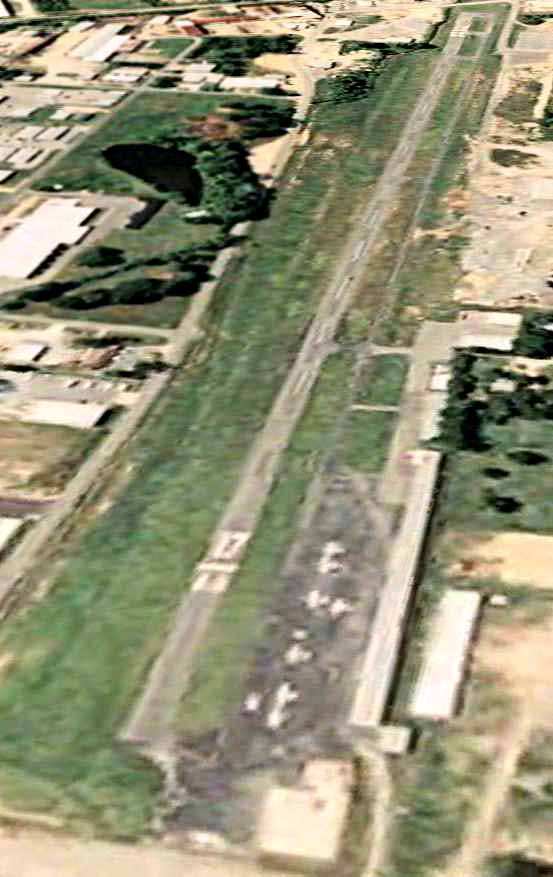
The last photo which has been located showing the original Saline County Airport still in operation was a 7/28/06 aerial view looking southeast (enhanced by Bill Grasha).
It depicted 8 single-engine aircraft parked on the northwest ramp.
According to Wikipedia, the original Saline County Airport consisted of 72 acres containing a single 3,980' asphalt Runway 17/35.
“For the 12-month period ending 8/31/06, the airport had 39,000 aircraft operations, an average of 106 per day.
At that time there were 44 aircraft based at this airport: 95% single-engine & 5% helicopter.”
According to Wikipedia, “Construction on the new Saline County Regional Airport began in November 2002 & it opened on March 12, 2007.
The existing was closed after the new airport opened.”
A 9/28/09 aerial photo showed the runway of the original Saline County Airport to be marked with closed-runway “X” markings,
and no aircraft on the field.

A 2/20/12 aerial view looking southeast showed the original Saline County Airport to remain intact, though abandoned.
The site of the original location of Saline County Airport is located southwest of the intersection of Route 67 & Airlane Drive,
appropriately enough.
Thanks to Devan Mayer for pointing out this airfield.
____________________________________________________
34.8, -91.92 (East of Little Rock, AR)

According to the Arkansas History Commission, the 640-acre Eberts Field
was named for native Arkansan, West Point graduate, and Signal Corps Captain Melchior Eberts.
Eberts died in May 1917 while making airplane exhibition flight at Columbus, NM.
Construction of Eberts Field began December 11, 1917.
The Primary Flying Course was an 8-week course with a student capacity of 300.
Eberts Field also housed a Temporary Storage Depot.
The earliest depiction of Eberts Field which has been located
was a a circa 1918 aerial view looking north at the field (courtesy of the Lonoke County Historical Society & Shirley McGraw).
It depicted the field as having a long row of hangars running north/south along the east side of the field,
with the airfield area to the west.

A circa 1918 photo of a JN-4 being refueled at Eberts Field (courtesy of Johnnie Bransford).

An undated photo of an Eberts Field JN-4 Jenny modified for gunnery instruction.
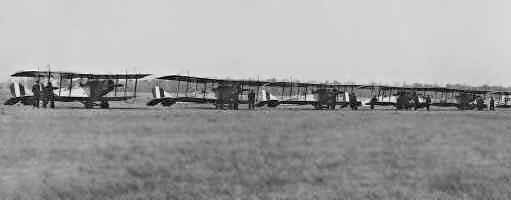
An undated photo of Eberts Field (courtesy of Colin Christie, enhanced by Bill Grasha).
According to Colin, the original panoramic photo depicted “the planes lined up... wing tip to wing tip... containing more than 100 planes.
Each plane has 2 soldiers at attention in front of their Jennys.
My Grandfather, George Christie, was a flight instructor at Eberts Field.”
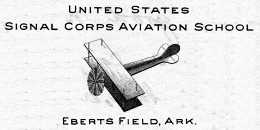
A 1918 Eberts Field postmark (courtesy of Dana Donahue) on a letter sent by Dana's Great-Uncle, (Frederick Dehmer).
Dana observed that Dehmer “as a young man apparently died of Pneumonia while stationed at Eberts Field in 1918.
As far as I know he made it to the rank of Corporal, although one of his letters makes it sound as if he was due for promotion to Sergeant soon and hoped to become a pilot.”
According to a historic marker at the site of the field,
approximately 2,500 enlisted men & officers were stationed at Eberts Field from 1918-19.
Although a large number of planes were reportedly operated from the field,
not a single fatal accident occurred at Eberts Field.

Several WW1-era photos of hangars & biplanes at Eberts Field (courtesy of Robert Horton).
The First World War ended (11/11/18) before Eberts Field's first class graduated.
Construction at Eberts Field ended in January 1919, at a total cost of $1,829,560.
The airfield at Eberts Field was evidently reused as Lonoke Municipal Airport,
as that is how it was listed in The Airport Directory Company's 1937 Airport Directory (courtesy of Bob Rambo).
The field was described as being located 1.5 miles west of the town of Lonoke.
It was said to consist of a 320-acre rectangular field, measuring 5,200' x 2,460'.
However, no airfield in Lonoke was depicted on the 1940 USGS topo map.
According to Scott Murdock, “I believe that this was also the site of a WW2 contract glider school,
operated by Kenneth Starnes Flying Service for the AAF.”
However, no airfield in Lonoke was listed in the April 1944 US Army/Navy Directory of Airfields (courtesy of Ken Mercer)
nor in the 1945 AAF Airfield Directory (courtesy of Scott Murdock).

A 12/19/75 USGS aerial photo showed that the row of at least a dozen concrete hangar foundations was still visible along the east side of the site of Eberts Field.
Some of the foundations had more recent sheds built upon them.

A single north/south “Landing Strip” was depicted along the eastern edge of the site of Eberts Field on the 1984 USGS topo map.

A single north/south “Landing Strip” was depicted along the eastern edge of the site of Eberts Field on the 1990 USGS topo map.
However, the majority of the airfield area of the former Eberts Field had been flooded & turned into a fish farm.

In the 2001 USGS aerial photo, the row of at least a dozen concrete hangar foundations was still visible along the east side of the site of Eberts Field.
It appears as if some of the foundations have had more recent sheds built upon them.
The majority of the former airfield area was filled in with fish ponds.

A 2005 photo by Scott Murdock of the remains of a concrete hangar foundation at the site of Eberts Field.
Scott observed, ““The line of hangars for this W.W.I airfield runs north-south, at the east edge of the former flying field.
I had access to the hangar foundations - about a dozen of them - via a paved road running north-south just to their west.
A historical marker describes the field & its wartime contribution.
Much of the area of the flying field itself is now bermed-up & used as a fish farm.”

A 2005 photo by Scott Murdock of a historical sign at the site of Eberts Field.
[The assertion that “a thousand planes” were used here is particularly suspect.]
The site of Eberts Field is located southwest of the intersection of Interstate 40 & Route 89.
____________________________________________________
Chaffee Army Airfield, Fort Chaffee, AR
35.304, -94.322 (Northwest of Little Rock, AR)

The 1947 USGS topo map depicted Ft. Chafee as having 2 runways, labeled simply as “Landing Field”.
Photo of the airfield while open has not been located.
Construction began on the Army's Fort Chaffee in September 1941.
From 1942-46, the base was used to train the 6th, 14th, and 16th Armored Divisions.
According to Al Fragola, “The post included a pair of sod runways for liaison-type aircraft used by the divisions,
however no formal airfield was established other than the runways.
The field on which the runways were made was adjacent to a vast tank & motor vehicle maintenance park.”
No airfield was yet listed among active airfields in the 1945 AAF Airfield Directory (courtesy of Scott Murdock)
The earliest depiction which has been located of Chaffee Army Airfield was on the 1947 USGS topo map,
which a pair of runways labeled simply as “Landing Field”.
No airfield at Ft. Chafee was yet depicted on the January 1949 Little Rock Sectional Chart (according to Chris Kennedy).

The earliest aeronautical chart depiction which has been located of Chaffee Army Airfield
was on the August 1953 Little Rock Sectional Chart (courtesy of Chris Kennedy).
It depicted “Chaffee AAF” as having a 2,200' unpaved runway.
According to Al Fragola, “It is thought that the sod strips on Ft. Chaffee
were originally charted as a cautionary measure due to their close proximity (3 miles) to Ft. Smith Regional Airport,
and Ft. Smith's establishment of an Air Traffic Control tower & commercial airline service.
Use of the sod strips by the Army was only occasional.”
For reasons that cannot be determined, the February 1959 Little Rock Sectional Chart (courtesy of David Brooks)
erroneously described the field as having 3 concrete runways, with the longest being 2,640'.
Chaffee AAF continued to be depicted on the February 1960 Little Rock Sectional Chart (according to Chris Kennedy).
Chaffee AAF was no longer depicted on the July 1964 Little Rock Sectional Chart (according to Chris Kennedy).
It was labeled “Abandoned Airfield” on the January 1965 Little Rock Sectional Chart (courtesy of David Brooks),
and was not depicted at all on the 1972 Memphis Sectional Chart (according to David Brooks).
According to Al Fragola, “A review of records by the Army & FAA in 1982
determined that the appearance & disappearance of Chaffee AAF on aeronautical charts through to the 1970s
seemed to be at the discretion of FAA officials at Ft. Smith Regional Airport,
depending upon perceived needs to depict its presence to civil aviation.
Prior to 1972, the Army never considered the facility more than an informal airstrip or helicopter landing area,
and never formally submitted airdrome data until the 1970s.
Chaffee AAF began being used for Army Reserve & National Guard helicopter unit summer training in the late 1960s.
By 1972, the intensity of these operations was considerable during the June–August timeframe,
and in 1975 the Army established a temporary ATC tower which operated under a letter of agreement with the FAA facility at FSM.”
Chaffee AAF was once again depicted on the 1977 Memphis Sectional Chart (according to David Brooks).

The May 1979 Memphis Sectional Chart (courtesy of David Brooks)
depicted the field as having only a 2,200' unpaved runway.
Al Fragola reported, “From 1982-85, I was the Airfield Commander for Chaffee Army Airfield.
Arrowhead Assault Strip was constructed & opened on my watch, and fell under my command as well.
During my tenure there, we had, on numerous occasions,
over 100 helicopters operating out of the airfield, all from units from everywhere.
Also regularly hosted teams doing doctrinal & equipment testing,
and operated a National Guard Air Traffic Control unit training program for 2 years.
Until my arrival, oversight of aviation activities was an additional duty for an officer at Ft. Sill, OK, some 200 miles away!
It was a great assignment for me, as we were upgrading the AAF facilities,
working with Army ATC in the development of tactical ATC doctrine, doing a tremendous amount of training support,
building AZU (which was also an active military parachute drop zone)
and working on the development of what would become the JRTC.”
Chaffee AAF continued to be depicted on Memphis Sectional Charts through the 1980s (according to David Brooks).
According to Al Fragola, “In 1983, Chaffee AAF was redesignated Chaffee Army Heliport,
and the sod runways were formally closed to fixed-wing traffic.
Heliport facilities were improved to provide reinforced concrete parking pads for 85 helicopters,
helipad lighting, a simple crash/rescue facility and improved ATC Tower.
No hangar facilities were ever built at the airfield.
The facility continued to be operated on an 'as-needed' basis, supporting Reserve/Guard units in the summer,
and an ever-increasing number of active-force units deploying to Ft Chaffee to use the excellent maneuver areas on the post.”
According to William Leeper, “The single concrete strip... is actually a road that widened out where it was an airstrip.
They simply set pipe bollards in the road to block it off when they were using it.”
According to David Brooks, in the mid-1980s the Army constructed another airfield 5 miles to the southeast,
called Arrowhead Assult Strip (AZU).
According to Al Fragola, “In 1987, Ft Chaffee became the site of the Army’s Joint Readiness Training Center (JRTC),
to which infantry units would deploy & train year-round.
Chaffee AHP was used by supporting helicopter units, and AZU was used as the 'tactical insertion airfield'.”
Chaffee AAF was no longer depicted on the 1991 Memphis Sectional Chart (according to David Brooks).
According to Al Fragola, “In 1993, the JRTC was moved to Ft Polk, LA, and Ft Chaffee ceased serving as an active Army post.
The land including Chaffee AHP has been turned over to commercial developers,
while the land including AZU was transferred to the Arkansas National Guard & continues as a military training site.”

The earliest photo which has been located of the Ft. Chafee Airfield was a March 1994 USGS aerial photo (courtesy of Dallam Oliver-Lee, enhanced by Bill Grasha).
It showed that the remains of 2 unpaved runways were still recognizable.

The 1995 USGS topo map depicted the field as having 2 unpaved runways, labeled simply as “Landing Field”.

A 2003 USGS aerial photo showed that the remains of 2 unpaved runways were still recognizable.
But roads had been constructed across some of the former airfield,
and some of the land had been plowed up along the southeast side.
A January 2006 aerial view (courtesy of Dallam Oliver-Lee) showed that a large building had been constructed over the northern portion of the airifeld site,
but the remains of 2 runways were still visible on the southern half.
William Leeper reported in 2014, “The structures that are located along the former runways are Mars Petcare, Umerex USA INC/ Walther Firearms, and Graphic Packaging.
I am VERY familiar with this area, and recall these air strips before they were built over.
The report of a single concrete strip is also accurate. It is actually a road that widened out where it was an airstrip.
They simply set pipe bollards in the road to block it off when they were using it.”

A 2016 aerial view showed the site of Chafee AAF was unrecognizable as ever having been an airfield,
with large buildings covering the northwestern portion, and a new highway having been built over the southeastern portion.
The site of Chaffee AAF is located southwest of the intersection of Route 253 & Route 255.
____________________________________________________
Since this site was first put on the web in 1999, its popularity has grown tremendously.
That has caused it to often exceed bandwidth limitations
set by the company which I pay to host it on the web.
If the total quantity of material on this site is to continue to grow,
it will require ever-increasing funding to pay its expenses.
Therefore, I request financial contributions from site visitors,
to help defray the increasing costs of the site
and ensure that it continues to be available & to grow.
What would you pay for a good aviation magazine, or a good aviation book?
Please consider a donation of an equivalent amount, at the least.
This site is not supported by commercial advertising –
it is purely supported by donations.
If you enjoy the site, and would like to make a financial contribution,
you
may use a credit card via
![]() ,
using one of 2 methods:
,
using one of 2 methods:
To make a one-time donation of an amount of your choice:
Or you can sign up for a $10 monthly subscription to help support the site on an ongoing basis:
Or if you prefer to contact me directly concerning a contribution (for a mailing address to send a check),
please contact me at: paulandterryfreeman@gmail.com
If you enjoy this web site, please support it with a financial contribution.
This site covers airfields in all 50 states.